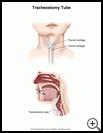
Tracheomalacia
What is tracheomalacia?
Tracheomalacia is a condition in which the walls of the trachea are very weak or soft. The trachea, also called a windpipe, is a tube made of muscles and cartilage. Rings of cartilage support the windpipe and keep it open during breathing. In tracheomalacia, the windpipe may be so weak that it collapses and may block the airway.
Tracheomalacia is most common in infants and small children. Most of the time it is a birth defect. However, tracheomalacia may also develop in:
- people who have breathing tubes in their throats for a long time.
- people who have an abnormal connection between the trachea and esophagus
- people who have severe gastroesophageal reflux disease (GERD).
What are the symptoms?
Symptoms of tracheomalacia include loud noisy breathing (stridor) and a loud barking cough. Your child may wheeze constantly, and be worse when crying, feeding, or coughing. Your infant's breathing will also be worse when he has a cold. Symptoms usually improve when the baby lies on his or her stomach or sleeps.
Most babies with this disorder seem happy and do not seem to be struggling when they wheeze. The wheezing does not improve when the baby is given medicines such as bronchodilators or anti-inflammatory drugs.
If tracheomalacia is severe, the child may struggle very hard for breath. Over time, the chest wall may become deformed. Babies may not be able to breathe and eat at the same time, and may not gain weight properly. If the airway is severely collapsed or blocked, the baby needs to be on oxygen.
How is it treated?
Tracheomalacia usually improves by the time the child is 6 to 12 months of age and goes away by 24 months of age. Children usually do not need medical treatment. Children with this condition do need to be carefully watched when they get respiratory infections.
If the condition is severe, does not improve, or causes growth problems, your child may need:
- Continuous Positive Airways Pressure (CPAP). CPAP is a device that sends air into the child's airway through a special mask placed on the face. The mask does not breathe for your child. It creates air pressure when the child inhales, and helps keep the airway open.
- Tracheostomy (also known as a tracheotomy). A tracheotomy is a procedure that makes an small opening in the neck and trachea. A tube is then placed in the opening to keep it open. The child breathes through this tube rather than through the mouth and nose.
Last modified: 2010-07-06
Last reviewed: 2010-03-02

